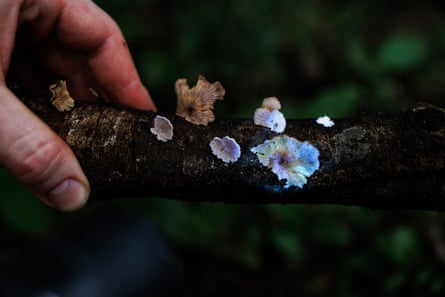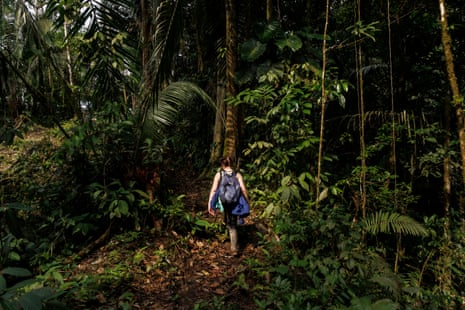Twilight is falling in the Ecuadorian jungle when the two scientists spot their first zombie. The smell of damp earth and vegetation rises as Alan Rockefeller takes slow, careful steps, scanning the forest floor with an ultraviolet light.
Suddenly, a fragment of undergrowth glows: strands of luminous cordyceps, turned fluorescent by the torch. Dubbed the “zombie fungus”, cordyceps is known for colonising its insect hosts compelling them to seek a suitable spot to release spores. That is the spot where the host will die.




-
Clockwise from top left: the team find a Cordyceps nidus, a species found in 2017 that fruits on a trapdoor spider; Rockefeller illuminates a Cookeina speciosa; next, he holds up a stick on which Schizophyllum commune grow, a common mushroom that glows in UV light; Rockefeller and Quark show four monkey combs
Mandie Quark kneels in the wet, spongy earth, carefully digging her fingers around the entomopathogenic fungus to unveil the insect nestled beneath the surface: a thumb-sized beetle. The pair carefully light and photograph their find before beginning their two-mile trek home.
Here in the mountains of Ecuador, the two mycologists have embarked on a research expedition in the unprotected rainforests of the upper Amazon. Their mission is to meticulously document some of the world’s rarest fungi, which have been rapidly declining due to changes in climate, illegal logging and mining.

The Amazon rainforest brims with some of the world’s most diverse flora and fauna. Countless species of fungi dot the landscape, many still unnamed and awaiting discovery. Rockefeller and Quark carefully collect data by photographing and cataloguing each specimen for submission to the national herbarium in Quito and eventual DNA sequencing.
Rockefeller and Quark’s ultimate aim is to share their discoveries about Amazonian fungi with the world, helping ecological conservation efforts in Ecuador and beyond. They work alongside the Indigenous Sacha Wasi community, who have invited the scientists to operate on their land, exchanging information on different fungi species and their culinary or ecological potential.






-
Top: Rockefeller scours a rainforest dirt wall for mushrooms. Middle section, clockwise from top left: Quark holds up a powerful handheld light; captures a marasmius pinwheel mushroom in her lens; Rockefeller sets up two lights to capture Clavaria schaefferi; Quark photographs Ophiocordyceps melolonthae. Above: Rockefeller is joined in his work by two women from the Sacha Wasi community
At the core of the process lies the art of myco-photography. Each click of the shutter is an attempt to capture a fleeting moment in the cycle of these fragile organisms, which spend most of their life underground. “My goal is to take the best photo possible to get people excited about biodiversity and make them want to learn more about mushrooms,” Rockefeller says.
The pair’s methods include macro photography with focus stacking, a technique that captures every intricate detail of a mushroom, as well as recording the microscopy of the spores and generating DNA “barcode data”. Through this methodology, they aim to ensure each recorded mushroom contributes to the current understanding of fungal biodiversity.

“Knowing what you have is really important for conservation,” Rockefeller says. “You can’t just say you have a rare unnamed mushroom – that doesn’t work.
“If you can give it a name, then you can preserve it. And if people are going to do chemical analysis to try to make a new discovery based on these fungi, they need a name they can use to communicate about which fungus they’re using. So taxonomy is really important for that reason.”

Most people will never have the opportunity to visit the rainforest and observe these diverse and elusive fungi, so Rockefeller and Quark have been sharing their findings on social media and app-based platforms, such as iNaturalist, Mushroom Observer, GenBank, and MycoMap, to enable others to scrutinise the intricate details – in some cases, before the species vanish.
While navigating challenging Amazonian terrain, they aim to open a window to the immense potential of fungi, and the importance of preserving irreplaceable ecosystems.




-
Back at base, the duo embark on the process of sorting and labelling the samples from their day’s work before putting them in the dehydrator. Once complete, the valuable haul will be taken to the national herbarium in Quito
“It is hard to stay in the present moment these days – we always have a million things trying to grab our attention,” Quark says. “But the work we are doing is drawing attention to the here and now, and inspiring others to do the same.”
She adds: “Mushrooms exist at the precipice of life and death. They remind us that existence is fleeting, and our human experience is also fleeting. Being there at the perfect moment to find a beautiful mushroom, you have to be present in all of your senses to appreciate that blip in time when the mushroom is at its most pristine.”

Find more age of extinction coverage here, and follow biodiversity reporters Phoebe Weston and Patrick Greenfield on X for all the latest news and features







